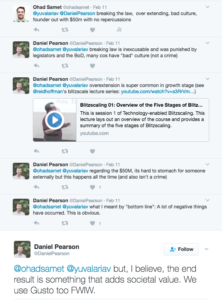The rolling dunes of the Israeli desert shift all the time. Leave a footprint, and soon enough it disappears. The wind blows fine sand around and covers your tracks, until only the Bedouin rangers can track you down, if at all.
***
When I was twenty-nine years old, my boss at PayPal was let go. They didn’t say why. He was going to spend time with his family, corporate PR said. It wasn’t the truth.
I called my VP. I’m ready to take over the branch office, I said. She was polite, but nothing came of it. No one would say it to your face over there. She didn’t think I was ready. I thought I was. I was wrong, but I didn’t know that.
A few months later, they announced they hired someone. He’s Chief Risk Officer at PayPal now. On his first day, when I met him, I said – it’s not personal, I’m leaving Israel. I’m going to San Jose. Ok, he said, how soon can you leave?
W–what? I’m indispensable! I didn’t say that. I just knew it to be true.
When I left, I thought there would be much fanfare. I had just turned thirty. I told the story of how I started five years earlier. I choked up a bit. People were very nice. They clapped when I finished my talk. There were pretzels.
Within two months, the team reorganized without me. I left footprints, slowly covered by the sands of time. A sentence in a job description. A procedure file. Several hires. Eventually even the Bedouin couldn’t find me. I was gone.
Confused, I called my mentor, Davidi. I don’t understand this thing, I said. How come I vanished this way, so fast? It was five years of my life.
Davidi sighed. When are you going to take your head out of your ass and understand that it’s not about you? He was fifty-five years old and slowly dying of cancer. Gentle delivery wasn’t a priority.
I didn’t get it then.
***
In 2011 I was thirty-one years old. I was Chief Risk Officer at Klarna and had just parted ways with a senior manager from my team. I had to, for various reasons. I didn’t say he was going to spend more time with his family. He went to start a risk management team at another company, and within a short while he poached M.
I didn’t think much of M, I told the COO. It was the truth. Losing him was okay. I’ll be worried if he hired F.
The following week, F gave his notice.
The CEO came to my apartment. He was upset. He was on the phone with the COO, his co-founder. Niklas says you said you couldn’t afford to lose F, he said. I didn’t have an answer. That night was the first time I lost sleep. It wasn’t the last.
Within two months, the team reorganized without them. Some signs lingered. Lines of code. A document or two. A couple of hires. But people rose to the challenge. Some I promoted, some hired. Eventually all of the old team’s footprints were gone, covered by the sands of time. The organization got over them.
***
I didn’t get it then but I get it now. People are important, but communities are stronger than the individuals that comprise them. Strong companies with strong momentum are especially resilient.
It’s not about you. It’s not about me. It’s about this construct we build and maintain, a company. It’s bigger than just us. It has a life of its own. You leave when your story ends, hopefully not too soon, and you leave a footprint, but the company lingers. It is stronger than any individual. People will rise to the challenge; they will grow into new roles. Some stories will diverge from ours and some will join in. And that’s how it’s supposed to be.

